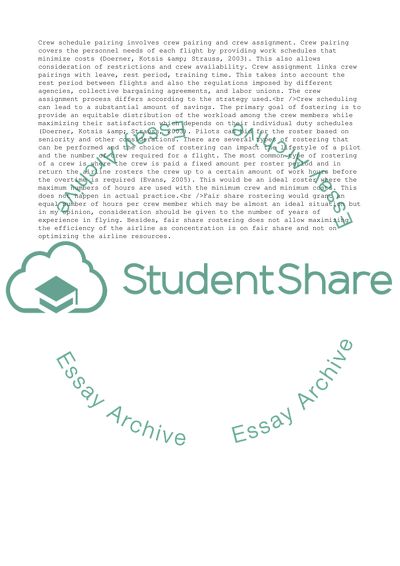Cite this document
(Roster Patterns Essay Example | Topics and Well Written Essays - 1000 words, n.d.)
Roster Patterns Essay Example | Topics and Well Written Essays - 1000 words. https://studentshare.org/business/1540894-should-roster-patterns-be-designed-primarily-to-suit-the-requirements-of-indivigualswhich-will-naturally-vary-from-one-indivigual-to-the-other-or-should-they-be-designed-to-maximise-the-efficiency-of-the-airline-does-flexibility-lead-to-in-equality
Roster Patterns Essay Example | Topics and Well Written Essays - 1000 words. https://studentshare.org/business/1540894-should-roster-patterns-be-designed-primarily-to-suit-the-requirements-of-indivigualswhich-will-naturally-vary-from-one-indivigual-to-the-other-or-should-they-be-designed-to-maximise-the-efficiency-of-the-airline-does-flexibility-lead-to-in-equality
(Roster Patterns Essay Example | Topics and Well Written Essays - 1000 Words)
Roster Patterns Essay Example | Topics and Well Written Essays - 1000 Words. https://studentshare.org/business/1540894-should-roster-patterns-be-designed-primarily-to-suit-the-requirements-of-indivigualswhich-will-naturally-vary-from-one-indivigual-to-the-other-or-should-they-be-designed-to-maximise-the-efficiency-of-the-airline-does-flexibility-lead-to-in-equality.
Roster Patterns Essay Example | Topics and Well Written Essays - 1000 Words. https://studentshare.org/business/1540894-should-roster-patterns-be-designed-primarily-to-suit-the-requirements-of-indivigualswhich-will-naturally-vary-from-one-indivigual-to-the-other-or-should-they-be-designed-to-maximise-the-efficiency-of-the-airline-does-flexibility-lead-to-in-equality.
“Roster Patterns Essay Example | Topics and Well Written Essays - 1000 Words”. https://studentshare.org/business/1540894-should-roster-patterns-be-designed-primarily-to-suit-the-requirements-of-indivigualswhich-will-naturally-vary-from-one-indivigual-to-the-other-or-should-they-be-designed-to-maximise-the-efficiency-of-the-airline-does-flexibility-lead-to-in-equality.


